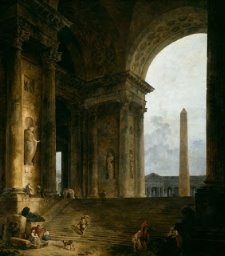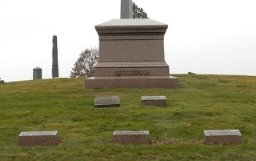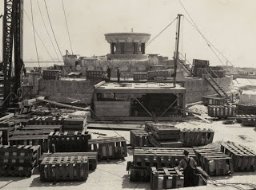Held at: | Internet |
Reference: | RS |
Source: | Internet – various sources |
Title: | Urishay Room: The Buckingham family and the Chicago Art Institute |
Place name: | Michaelchurch Escley, Golden Valley |
Date: | 1920s |
Description:
The Baker University Collection on this website provides the background to how the Drawing Room from Urishay Castle near Michaelchurch Escley was removed in the early 1900s and exported to America as architectural salvage. In the 1920s it was acquired – probably from Marshall Fields department store where it was used as a display – by the wealthy Buckingham family and donated by them to the Chicago Arts Institute.
This paper gives some additional information on the Buckingham family and the nature of their involvement in that transaction.
Donation of Urishay Room to Chicago Art Institute
Ref: Bulletin of the Art Institute of Chicago Volume 15 No 2 February 1921 Page 122
“Opening of Buckingham Jacobean Room
The gift of the late Clarence Buckingham, the late Miss Lucy Maud Buckingham and Miss Kate S Buckingham in memory of their parents Mr and Mrs E Buckingham.”
Clarence Buckingham
August 28, 2013 will mark the one-hundredth anniversary of the death of Clarence Buckingham. Were it not for the fountain in Grant Park that was given in his memory he would be largely forgotten today.
Clarence Buckingham was born on November 2, 1854 in Zanesville , Ohio , the eldest of three children born to Ebenezer and Lucy (Sturges) Buckingham. The family moved to Chicago when Clarence was a young boy, and it was from here that his father rapidly expanded his successful business building and operating grain elevators.
2000 block of Prairie Avenue looking north
Buckingham house at far left
The family’s North side home was destroyed in the Great Chicago Fire, and in 1875 they moved into their new home at 2036 S. Prairie Avenue . The new residence housed a valuable collection of art which in time became one of the finest private collections in the city. An article in the Chicago Tribune dated May 6, 1883 entitled “Some of the Notable Pictures in the Collection of Mr. E. Buckingham, of This City” described in detail a number of the works, many of which were watercolors. The Buckinghams instilled a love and appreciation of art upon their three children, which would have a profound effect upon those children later in life.
Ebenezer Buckingham died in 1912, leaving a $4 million estate to his three unmarried children (his wife had died in 1889). By that time, Clarence had become a successful businessman in his own right. Starting out in his father’s company, he later became a broker and a director of both the Corn Exchange National Bank and the Illinois Trust and Savings Company. He also served as president of the Northwestern Elevated Railroad Company, and was involved in insurance, steel and real estate.
Clarence Buckingham’s strong interest in art blossomed in the 1890s when he began assembling a collection of Japanese woodblock prints of exceptional quality and range, assisted by Art Institute curator Frederick W. Gookin and architect Frank Lloyd Wright.
The Obelisk by Hubert Robert
Gift of Clarence Buckingham, 1900
Courtesy of the Art Institute of Chicago
Currently on display in Gallery 218
A director of the Art Institute for more than a decade, he frequently loaned items from his personal collection for exhibition. He also purchased and gave artworks directly to the Art Institute.
Buckingham died on August 28, 1913, one week after returning to Chicago from his new summer residence at Lennox , Massachusetts . He had been in good health up to within a few weeks of his death, so his sudden demise at the age of 58 was a shock to his family and friends. He was interred at Woodlawn Cemetery in Zanesville , Ohio .
Evening Glow by Katsushika Hokusai
Clarence Buckingham Collection, 1925.3201
Courtesy of the Art Institute of Chicago
Currently on display in Gallery 107
Portrait of Edouard Manet by Henri Fantin-Latour
Clarence Buckingham Collection, 1967.595
Courtesy of the Art Institute of Chicago
Currently on display as part of the exhibition
"Impressionism, Fashion, and Modernity"
In 1914, his sister Kate loaned his entire art collection to the Art Institute. She continued to acquire additional works and in 1925 she formally gave the prints to the museum, along with an endowment to maintain and expand the collection. The Clarence Buckingham Collection originally contained about 2,500 works and has grown through purchases and gifts to more than 16,000. (It was also in 1925 that Kate Buckingham razed the old family home on Prairie Avenue when she relocated to a spacious apartment on Lakeview Avenue on the North side.)
The lasting legacy of Clarence Buckingham, of course, is the fountain that bears his name in Grant Park. Officially called the “Clarence Buckingham Memorial Fountain,” the project was announced in January 1924, when the South Park board of commissioners voted to accept the gift of $250,000 from Kate Buckingham for the fountain’s construction, along with an additional $135,000 for a maintenance fund. The design of the fountain, twice the size of that of Latona at Versailles , was overseen by Edward H. Bennett of the firm of Bennett, Parsons & Frost.
Work commenced in August 1925 by which time the cost had increased to nearly $700,000. It would take two years to complete. The fountain was officially dedicated on August 26, 1927. An estimated 50,000 people attended the ceremonies and watched the inaugural performance of the fountain’s water jets and colored lights, set to a live performance of the “Stars and Stripes Forever” performed by John Philip Sousa’s band.
James O’Donnell Bennett, a columnist for the Chicago Tribune , writing about the fountain just a week after its dedication, said in part:
“In a week the Buckingham fountain has captured the imagination of the town, enlarged its aesthetic sense, and done it spiritual good. The gift is more than a memorial to Clarence Buckingham. It is an expression of the lake by which it is fed and which it extols. As such, Chicago has comprehended it and as such loves it. It is the lyric of the lake. It will never grow old or commonplace. Sunlight and shadow, mounting and waning breeze will ever renew and ever vary its spectacle and its song. It will go on forever.”
Observations:
None
Ref: rs_mic_0347








